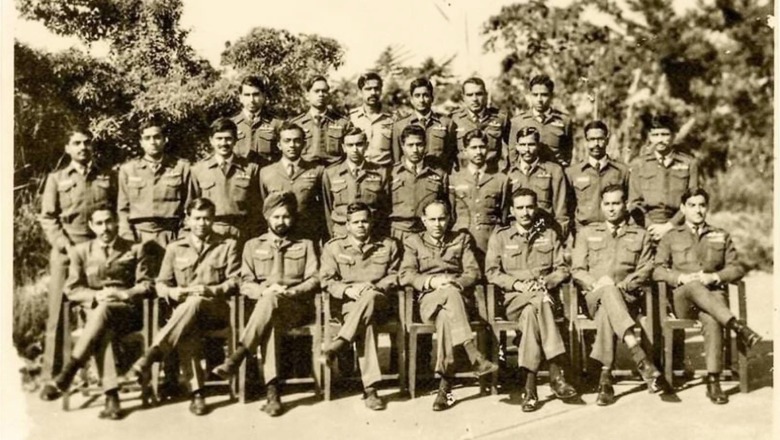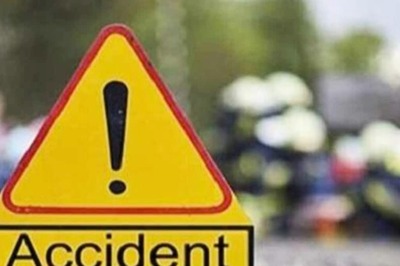
views
“It was a short burst,” says veteran Air Marshal Harish Masand, a Vir Chakra and Vayu Sena Medal awardee. “The four guns on the Hunter aircraft I was flying spat out 18 rounds in a mere quarter of a second and they hit the Pakistan Air Force Sabre jet being flown by Flight Lieutenant Saeed Afzal.”
The PAF pilot had bailed out and was presumed killed in action as he was never found. He was awarded the Sitara-I-Jurrat posthumously.
The Mhow-based veteran was remembering the action on December 4, 1971, when he was a member of a team of Hunter fighter aircraft which took on the PAF. They were from the 37 Squadron (Black Panthers) of the IAF based in Hasimara, West Bengal. The Commanding Officer was Wing Commander Swaroop Krishna ‘Suppi’ Kaul who would later become the Chief of Air Staff.
“That day I remember that I had, by force of habit, first pressed the camera button and then realising my mistake, I fired from my guns which were capable of firing 20 rounds per second per gun. The shooting down of the Sabre was recorded by my plane’s camera and the film was developed and sent to Air HQ, Delhi, and the HQ Eastern Air Command, Shillong. My mind’s eye remembers every detail as if it were yesterday,” Masand recollects.

Air Marshal Harish Masand in his younger days. (News18)
He was flying one of three Hunter fighter planes which had taken off to conduct a raid on the Tezgaon airfield in erstwhile East Pakistan. The other two pilots were CO Suppi Kaul and his wingman Billoo Sengar. “My landing gear had refused to go up,” said Masand, “so I had to use the emergency override switch and catch up with the other two planes.”
“We had been conducting flying reconnaissance missions over East Pakistan since October 1971 as we knew that war was imminent and we should collect as much data as possible which would help our Armed Forces, especially the army, once war was declared,” said Masand, who was a young Flying Officer at that time.
The 1947 Quetta, Balochistan born veteran fighter pilot, whose parents settled in Indore, had completed his schooling from St Raphael’s School, Indore. He had then joined the Shri Govindram Seksaria Institute of Technology and Science, SGSITS, Indore, or GSTI as it was then known, for his bachelor’s degree in engineering which he left midway to join the IAF and he was commissioned from the Jet Training Wing, JTW, Hakimpet on December 31, 1967.
During the 13-day war, Masand participated in 20 flying missions. The most memorable of these was on December 14.
Indian Intelligence had come to know that the Governor of East Pakistan AM Malik, Pak Eastern Army commander Lt Gen AAK Niazi and the entire top hierarchy of East Pakistan would be meeting at the palatial Government House on December 14 to discuss surrendering to the Indian Armed Forces.
The IAF decided to launch air attacks on the Government House while the meeting was on to shake up the top leadership. This was done with only 55 minutes of notice. The first attack was by four Mig-21 planes of the Gauhati (Guwahati) based 28 Squadron. Four Hunter aircraft of the 37 Squadron, including Masand, followed soon after.
These attacks were conducted using tourist maps published by the Burmah Shell company. The target was changed from the Circuit House to Government House just before the planes took off. The pilots were understandably nervous as they didn’t want to cause collateral damage and harm innocent civilians. But the attacks went off beautifully and only the Government House was hit and that too when the meeting was on.

A painting by Wing Cdr Rakesh Chauhan showing the attack on Government House, Dacca. (News18)
“I remember seeing a prominent door and windows on the first floor not far from the dome on the ceiling,” Masand said. “We guessed that this could be the conference room and it is through these that we fired our guns and cannons. Thanks to this well-timed attack, Governor Malik — who hadn’t yet made up his mind — quickly wrote his resignation letter while shaking and hiding under a table and Lt Gen Niazi, who took over, forgot his bluster and decided to surrender along with 93,000 troops on December 16.”
In 1987, Masand had the honour of commanding 28 Squadron then based in Pune and now equipped with Mig-29s.
The next day, December 15, Masand was part of an attack carried out by 37 Squadron in the Dacca University area to further demotivate the Pakistani troops who were occupying the premises. The joy of victory wasn’t without its moments of sadness as Masand’s younger brother, Lt Bharat Masand of 7 Para, was killed in action on December 8 in the eastern sector. His elder brother, Flight Lt. Manohar Masand, was awarded the Vayu Sena medal for bravery. The CO of 37 Squadron Wing Commander SK Kaul was awarded the Mahavir Chakra and Flying Officer Harish Masand the Vir Chakra by the then President of India VV Giri at a simple investiture ceremony at the Rashtrapati Bhavan in November 1972.
Harish Masand retired as an Air Marshal in 2006 and his last posting was in Bangalore as Advisor Light Combat Aircraft program. He is now settled in a colony of retired defence officers in Mhow, Indore district, MP, with his wife Amrita.
(As told to guest writer DK Vasudevan)
Read all the Latest India News here




















Comments
0 comment